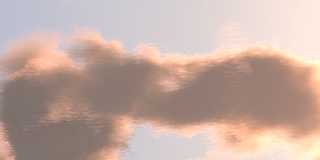 |
 |
|
 |
|
 |
|  |
|  |
|
 |
|
 |
|  |
|  |
|
 |
My "A Rose" image is ready and off to print. Still, using 75 intervals for
the final render at 3200x2400 showed these "layering" artifacts on close-up
of the clouds. Looks much like "stacked planes technique" here, and I guess
this is due to how the intervals are spread across the interior of the
object: they sample at the same layers.
Anyways, I've used method 2 for this one, with 75 intervals and 1,1 min- and
max-samples. The Docs say that using different sample-values would lead to
random noise much like the initial method 1 of POV 3.1g. I want to
experiment a little with it later on to see if I can exploit the randomness
to hide the "mathematicalness" of media in future images. First though, I
wanted to ask here if anyone has similiar experiences and already has some
tricks up his sleeve which he/she might want to share with us?
Regards,
Tim
--
"Tim Nikias v2.0"
Homepage: <http://www.nolights.de>
Post a reply to this message
Attachments:
Download 'bday_clouds.jpg' (18 KB)
Preview of image 'bday_clouds.jpg'

|
 |
|  |
|  |
|
 |
|
 |
|  |
|  |
|
 |
Tim Nikias v2.0 wrote:
>
> Anyways, I've used method 2 for this one...
Er. Why not use method 3?
-Xplo
Post a reply to this message
|
 |
|  |
|  |
|
 |
|
 |
|  |
|  |
|
 |
> > Anyways, I've used method 2 for this one...
>
> Er. Why not use method 3?
Is there much difference when comparing
method 2 intervals 75 samples 1,1
to
method 3 intervals 1 samples 75,75?
I'm not 100% sure, but AFAIK, there isn't. On some objects (especially where
interior areas follow in succession) method 3 creates artifacts, hence my
reliance on method 2, even though the use here would have allowed method 3.
I want to work with method 2 because of above mentioned artifacts, so...
--
"Tim Nikias v2.0"
Homepage: <http://www.nolights.de>
Post a reply to this message
|
 |
|  |
|  |
|
 |
|
 |
|  |
|  |
|
 |
-----BEGIN PGP SIGNED MESSAGE-----
Hash: SHA1
Tim Nikias v2.0 wrote:
|>>Anyways, I've used method 2 for this one...
|>
|>Er. Why not use method 3?
|
|
| Is there much difference when comparing
| method 2 intervals 75 samples 1,1
| to
| method 3 intervals 1 samples 75,75?
|
No, but to get full use of the method 3, you shouldn't set the same
number for min samples and max samples. The whole point of method 3 is
that it starts with min samples and adds more where they are needed.
You might also want to take a look at MegaPov 0.7 and the
sample_spacing keyword. It causes the media to be sampled more in
parts of the render where the ray travels a longer way through the
media. In your scene, that means that more samples will get taken near
the horizon (where I assume the banding will be harder to get rid of).
Jerome
- --
******************************
* Jerome M. Berger *
* mailto:jbe### [at] ifrance com *
* http://jeberger.free.fr/ *
******************************
-----BEGIN PGP SIGNATURE-----
Version: GnuPG v1.2.2 (GNU/Linux)
Comment: Using GnuPG with Mozilla - http://enigmail.mozdev.org
iD8DBQFAvMIjqIYJdJhyixIRAm89AJ9tsMAXfINWDFu82psLu1a6sSP0QwCcCzVr
6rjuEs9Jet0OlvbIypa+FIA=
=/+xg
-----END PGP SIGNATURE----- com *
* http://jeberger.free.fr/ *
******************************
-----BEGIN PGP SIGNATURE-----
Version: GnuPG v1.2.2 (GNU/Linux)
Comment: Using GnuPG with Mozilla - http://enigmail.mozdev.org
iD8DBQFAvMIjqIYJdJhyixIRAm89AJ9tsMAXfINWDFu82psLu1a6sSP0QwCcCzVr
6rjuEs9Jet0OlvbIypa+FIA=
=/+xg
-----END PGP SIGNATURE-----
Post a reply to this message
|
 |
|  |
|  |
|
 |
|
 |
|  |
|  |
|
 |
> No, but to get full use of the method 3, you shouldn't set the same
> number for min samples and max samples. The whole point of method 3 is
> that it starts with min samples and adds more where they are needed.
I know, just in recent attempts I've noticed that I had to set min-samples
quiet high to get good results, probably because I'm using pretty extreme
settings for my media. I'm not sure how method 3 figures if it should raise
the samples, but I guess that extreme details and small-scale densities
aren't easy to handle for such an algorithm. So, along with the mentioned
artifacts, I've turned to method 2, as I have a more definite idea of what
I'm doing when I'm changing values. Hence this thread, I want to get some
more knowledge of it and figure how to do things different to achieve better
effects.
> You might also want to take a look at MegaPov 0.7 and the
> sample_spacing keyword. It causes the media to be sampled more in
> parts of the render where the ray travels a longer way through the
> media. In your scene, that means that more samples will get taken near
> the horizon (where I assume the banding will be harder to get rid of).
MegaPOV... I've only used it once to get a look at isosurfaces before 3.5
came out, aside of that, I like to stick to the official version.
Tim
--
"Tim Nikias v2.0"
Homepage: <http://www.nolights.de>
Post a reply to this message
|
 |
|  |
|  |
|
 |
|
 |
|  |
|  |
|
 |
> Anyways, I've used method 2 for this one
Bad choice if you ask me. Prefer method 3 to method 2; method 3 makes an
effort to clear up the type of artifacts you're getting. You might even try
method 1; graininess is much better than the artifacts you're getting (IMO).
Otherwise, just make sure your media container is as tightly enclosed around
the clouds as possible.
- Slime
[ http://www.slimeland.com/ ]
Post a reply to this message
|
 |
|  |
|  |
|
 |
|
 |
|  |




![]()